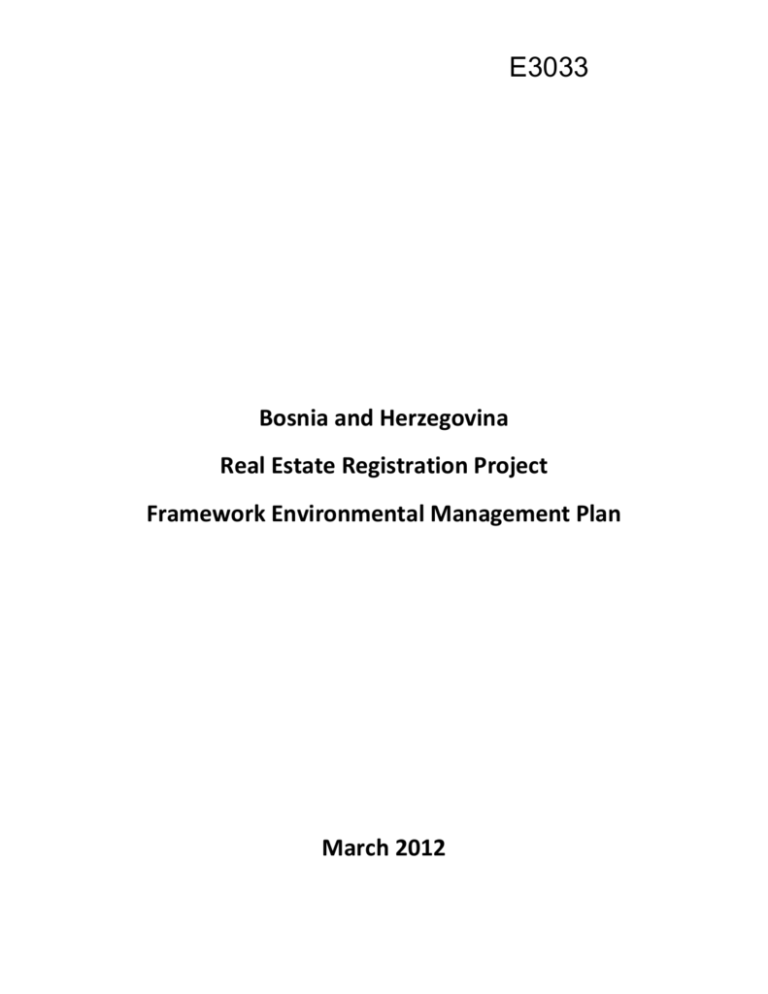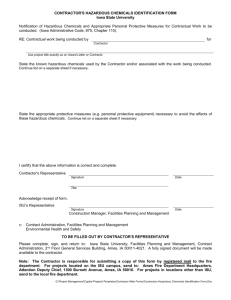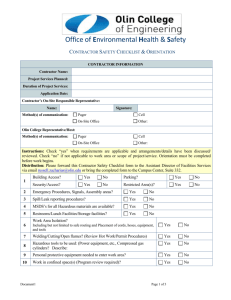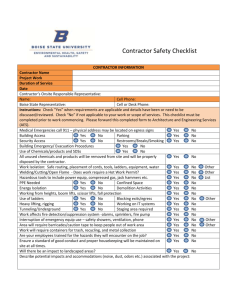E3033 - Documents & Reports
advertisement

E3033 Bosnia and Herzegovina Real Estate Registration Project Framework Environmental Management Plan March 2012 GENERAL INFORMATION The Real Estate Registration Project activities would focus on cadastre and land registry data updating and harmonization and integration of this data in urban areas. This is due to the fact that the activity rate of property markets, as well as the discrepancy rate between cadastre and land register data, is much more significant in urban and peri-urban areas than in rural areas. There is great potential for a boost in the economy if non-registered urban properties were included in the formal registration systems. Up-to-date spatial data is in high demand in urban areas also in support of the urban planning and plan upgrading that addresses the question of buildings without the permit of use, and for property taxation. The project would have three components: A) Real estate registration data development B) Real estate registration infrastructure development C) Policy and institutional development, and project management Component B of the project will include funding for renovation of offices. Drawing on the experience of successful EMP development and implementation for the ongoing Land Registration project which financed the same types of works, a similar approach will be taken for this Project as well. DESCRIPTION OF WORKS AND ASSOCIATED ENVIRONMENTAL IMPACTS The works will mostly entail indoor rehabilitation and refurbishment of existing, or newly acquired office space for the Real Estate Registration Offices. Minor construction, carpentry and masonry works are envisaged, including physical arrangements which would facilitate operations and user-friendliness of the offices. Main environmental impacts envisaged at this stage would deal with following sound construction practices - as related to disturbances to the immediate neighbors, dust and noise generation, waste management, chance findings and possible encounters of hazardous wastes or materials such as asbestos. The works will not include land acquisition or works beyond the existing footprints of the buildings. The works will not include demolition of buildings and will be done in respect to all of the legal requirements in country and/or entity, as well as the World Bank’s Operational Policy 4.01 on Environmental Assessment. Since the exact locations of future works are not known at this stage, a template EMP within this document will be used for all future locations, revised and adapted as per the local conditions on site. It is also the Client’s obligation to be aware of, and to meet all of the local permitting requirements. ANALYSIS OF LOCAL ENVIRONMENTAL AND PERMITTING REQUIREMENTS The following laws have provisions on construction and reconstruction activities in the two entities of Bosnia and Herzegovina: FBiH: • Law on Physical Planning and Land Use(official Gazette of FBiH, No 02/06) and • Law on Construction Land (official Gazette of FBiH, No 25/03) RS: • Law on Spatial Planning (official Gazette of RS, No 84/02), • Law on Construction Land (Official Gazette of RS, No 41/03, 86/03) Environmental Impact Assessment The Environmental Impact Assessment and the issue of Environmental Permitting for the investment construction projects and industrial facilities are regulated by the Laws on Environmental Protection in both entities and District Brcko, including appropriate bylaws on plants and processes that can only be placed into operation if they possess an environmental permit. According to this legislation, an environmental permit is not necessary for reconstruction works within a building, whereas new construction can be mandated to have an environmental permit based on the characteristics of the building. In RS, environmental permits for significant potential polluters are issued at the Entity level, while the lesser polluters are dealt with at the Municipal level. In Federation BiH, the permitting procedure is conducted in a similar manner, where the municipal level is replaced by the Cantonal level. The environmental permits also contain provisions of the Laws on Waste Management of both entities. Permits Required for Construction Works • Location /urbanistic Permit • Environmental Permit (if deemed project may have a negative environmental impact) • Construction Permit • Operational Permit Note: In cases where the façade or the entire building is placed under a form of protection of state or entity, the adequate procedures must also be respected, and opinions of relevant institutes obtained prior to start of works. ENVIRONMENTAL MITIGATION PLAN Design Phase Issue Mitigation Measure Costs Institutional Responsibility Reviewing rehabilitation plans/ detailed design Harmonization with measures proposed in EMP (accessibility, energy efficiency, use of environmentally friendly construction materials, etc.) Part as a project activities, included in operating cost Contractor’s design team and Project Management Team (PMT), Works on buildings that are under a form of protection by the state (monuments) Ensure that rehabilitation works are within the interior of the building To be determined Project Management Team Seek clearance from the relevant authorities (Entity Institutes for Monument Protection or State Commission on Protection of Monuments) Comments Construction Phase Issue Mitigation Measure Costs Institutional Responsibility Comments End-of-life equipment, office furniture or other miscellaneous waste Reuse and recycling whenever possible; adequate disposal at approved and appointed disposal site in other cases Contractor and/or end user – Cadastral office Construction waste Separation of wastes, reuse and recycling whenever possible Contractor (or other entity, depending on the Contract) Will be specified in bidding documents (compliance with EMP) Contractor The contractor needs to organize a training for all staff on how to recognize asbestos, and to establish procedures for removal of asbestos using adequate protective equipment, limiting breaking of asbestos, and storing it safely in airtight containers before handling over to authorized removal agencies (as per the Entity ministry list of Hazardous waste management companies). Disposal of non-recyclable waste organized with municipal service providers; no burning or illegal dumping Hazardous wastes (possible small quantities, e.g. paints, oils) handled separately, according to relevant regulations; handling of hazardous wastes has to be documented Removal of asbestos containing materials Removal of asbestos pipes will comply with all applicable state and federal regulations, including those for construction standards, health and safety, emission standards for hazardous air pollutants and transport and disposal of hazardous waste. (In lieu of national legislation use Directive 2003/18/EC of the European Parliament and of the Council of 27 March 2003 amending Council Directive 83/477/EEC on the protection of workers from the risks related to exposure to asbestos at work: highest permissible concentration of respirable dust to 0.1 fiber/cm3; Good Practice Note: Asbestos: Occupational and Community Health Issues, the World Bank) To be agreed during construction, if relevant Construction Phase Issue Mitigation Measure Costs Chance finds If encountering archaeological findings during rehabilitation works, contractor should stop operations and notify competent authorities Noise Working hours limited to daily shifts N/A Ensure minimal disruption to other users of the building Contractor’s cost Institutional Responsibility Comments Contractor Contractor Use of attested machinery No idling of machinery or transport vehicles on site Dust Watering or coverage of dusty materials; adjusting the speed of vehicles in transport Contractor’s cost Contractor Dust from demolition works can be minimized by enclosing the object; workers should wear appropriate equipment Use chutes for disposal of waste material from higher floors Construction materials Requirements for energy efficient and environmentally friendly materials integrated in procurement notices, and adequate choices made at procurement N/A Contractor Site organization and restoration Plans to minimize disturbances to the neighborhood made (including plans to avoid traffic jams based on heavy duty equipment and/or transport of materials) N/A Contractor Fencing off the construction site and/or safety signs and warnings clearly posted as applicable The site will be cleaned from all debris and waste materials and restored to the state planned in the designed upon completion of works; all machinery will be removed Design documents to include specifications Design documents to include specifications Contractor’s cost Contractor’s cost Operational Phase Issue Generation of solid waste on premises Mitigation Measure Adequate measures for recycling and reuse of all such materials (including paper and old equipment/furniture) Costs Institutional Responsibility End user Buildings should have contractual agreements with local public utilities on waste collection and management Connection to a wastewater collection system The building should either have a connection to the wastewater collection system, or an adequately sized and designed leak-proof septic tank with regular maintenance schedules through an accredited company End user Comments ENVIRONMENTAL MONITORING PLAN AND SUPERVISION Construction Phase WHAT Parameter to be monitored WHERE Is the parameter to be monitored On site HOW Is the parameter to be monitored Part of regular inspection WHEN To monitor the parameter (frequency) During construction at intervals in accordance with national legislation Construction Inspectorate Construction waste management (including hazardous) On site Visual inspection of waste piles and intervals of removal Weekly Site Supervisor to monitor Presence of asbestos and other hazardous materials On site Rehabilitation works are conducted in line with relevant regulations (construction permit, if it will be necessary) RESPONSIBILITY Contractor to implement Review documentation for waste collection and/or hand over, especially for hazardous wastes Visually Weekly, have workers notify at first notice Site Supervisor to monitor Contractor to implement Noise and dust emissions On site Sensory Upon complaint Safety signs and notifications On site Visual inspection At start of the works and every 30 to 60 days thereafter Site Supervisor to monitor Prior to start of works Site Supervisor to monitor Contractor to implement Contractor to implement EMP IMPLEMENTATION RESPONSIBILITIES The Environmental Management Plan provided in this document will be reviewed for each of the proposed Project locations and adjusted based on the varying local conditions. Such an updated EMP will be disclosed in a public place prior to, and for the duration of start of works. The EMP will also be a part of the bidding and contractual documents, binding therefore the hired Contractor to implement all of the listed mitigation measures and for the hired Supervisor to ensure all of the measures have been implemented. The Site Supervisor will provide a section on compliance with the EMP in their regular progress reporting. Overall responsibility for the implementation of this EMP stays with the Project Implementation Unit – that is Administrations for Geodetic and Real-Property Affairs of both Entities. The project is to be implemented by the in close cooperation with the respective MOJs in accordance with the requirements of the project. CAPACITY DEVELOPMENT AND PROPOSED PROJECT ORGANIZATION Even though the overall responsibility remains with the PIU, and knowledge of the World Bank environmental safeguard requirements will be shared with the PIU, the bidding and contractual documents will be used to transfer this obligation onto the Contractor. It is desirable for the chosen Site Supervisor to be knowledgeable of the environmentally-friendly construction processes, and to organize a brief training on EMP compliance with the Contractor and staff prior to start of works. PUBLIC DISCLOSURE The Framework EMP, along with an invitation to the public consultation meeting was disclosed publically on the web-pages of the Federal Ministry of Justice (www.fmp.gov.ba) and the Federal Administration for Geodetic and Real-Property Affairs (www.fgu.com.ba) in early March 2012. The public consultation was announced in the daily papers (Dnevni avaz and Nezavisne novine) with targetted invitations sent to already identified potential stakeholders from a number of institutions and entities at various levels, that deal with environmental protection. As the Framework EMP was small in size, it was easy to send it with the invitations, most of which were done by e-mail or fax. The public consultation meeting was held on March 20, 2012 in the Federal Ministry of Justice, Valtera Perica street 15, in Sarajevo, starting at 11:00. This public consultation meeting was done for both entities and was organized in cooperation by the PIUs from FBiH and RS. Based on the discussion during the public consultation meeting, there are no significant (or any) changes to be made to the Framework EMP. Most of the discussion was related to the local procedures and raising environmental awareness in the manner that the World Bank is requiring this Project to do. List of attendees and Minutes of Meeting are given in Annex 1 of this document. ANNEX 1 : MINUTES OF MEETING FROM PUBLIC CONSULTATIONS AND LIST OF ATTENDEES Real Estate Registration Project – BiH Minutes of Meeting from Public Consultations for the Framework EMP Public consultations held in Sarajevo, March 20, 2012. The public consultation meeting was opened by Mr. Edib Mehmedovic, manager of the PIU in Federation BiH, presenting both the current Land Registration Project and the future Real Estate Registration Project. The opening statement was also strengthened by Mr. Hidajet Halilovic, Assistant Minister of Justice of FBiH, with an introduction of the state of cadastre and land registration books. Mr. Darko Miskovic, Assistant Director of the Republic Administration for Geodetic and Real-Property Affairs of Republika Srpska spoke of the current situation and conditions in RS. Vedran Kordic, on behalf of the two PIUs presented the Framework EMP document. Mr. Mladen Rudez, Assistant Minister of Environment and Tourism of FBiH has spoken highly of the requirements of the World Bank on integrating environmental protection as a pre-requisite of their projects, and to have such public consultations, as the overall situation in BiH does not provide for much support to the environmental protection. Mr. Rudez has elaborated on the legal framework for environmental protection in BiH as well as the mechanism of environmental permitting, and the advances made in this field. He has explained that in 2002/2003 a set of 6 new environmental alws has been drafted and that the EU Directives mentioned in the Framework EMP are integrated into the Entity laws. Ms. Belma Kljuco Vlasic on behalf of the Novo Sarajevo municipality has stated that in FBiH there is a separation of responsibilities between the Municipality, Canton and the Federation, and that there is a lack of clarity who is responsible over what parts of environmental protection, but that for the Real Estate Registration Project the Framework EMP will serve as a guideline. She also asked from the Federal Ministry of Environment and Tourism to organize a seminar or workshop on environmental permitting. Mr. Igor Dizdar on behalf of the Federal Ministry of Physical Planning has explained the varied levels of responsibility between the Municipality, Canton and Federation related to construction permits, and noted that for reconstruction of the land or real-estate registry offices no permits would be needed, and that such works would be considered as “regular maintenance” except in cases when the building is under a specific form of protection (monument of culture, heritage site, etc.) Ms. Azra Agic on behalf of the Novi Grad Sarajevo Municipality has expressed her satisfaction with the rules and procedures that are required by the World Bank. Ms. Antonija Sikimic on behalf of the Federal Administration for Geodetic and Real-Property Affairs has joined in the discussion related to the environmental permits and responsibilities specifically touching upon the issue of preventing illegal construction in industrial areas and legalization of such buildings.






